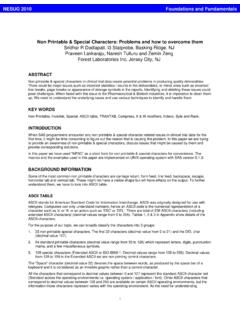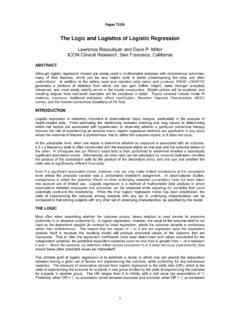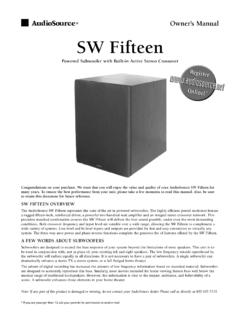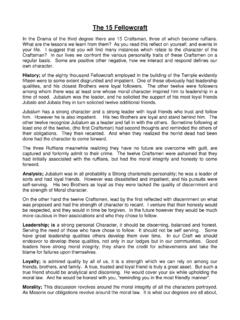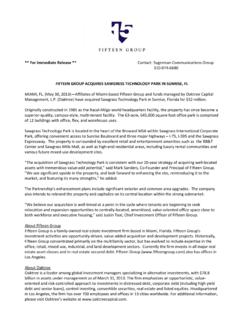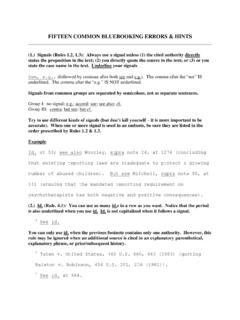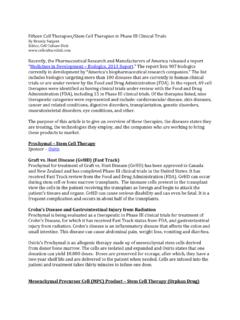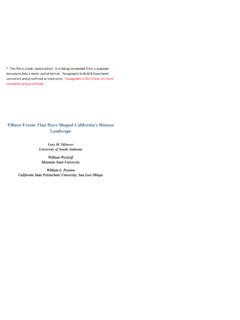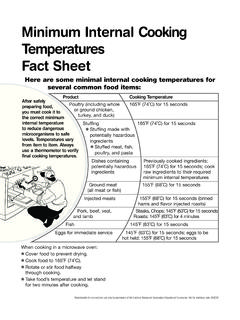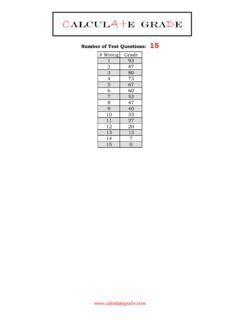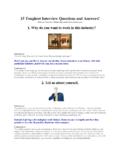Transcription of Fifteen Functions to Supercharge Your SAS Code
1 1 WUSS 2017 Fifteen Functions to Supercharge your SAS Code Joshua M. Horstman, Nested Loop Consulting, Indianapolis, IN ABSTRACT The number of Functions included in SAS software has exploded in recent versions, but many of the most amazing and useful Functions remain relatively unknown. This paper will discuss such Functions and provide examples of their use. Both new and experienced SAS programmers should find something new to add to their toolboxes. INTRODUCTION As of version , the Base SAS product includes a comprehensive library of over 500 Functions and call routines. Together, these provide an immense wealth of functionality to the SAS programmer. The Functions cover a variety of topics including string manipulation, dates and times, math and statistics, type conversions, information about data sets and variables, logic and program control, and much more. This paper will describe just a tiny fraction of those Functions , with a focus on Functions the author has found useful in a broad range of situations.
2 The Functions here are grouped into three categories: string manipulation Functions , logic and program control Functions , and Functions for handling missing values. STRING MANIPULATION Functions 1. CATX ENHANCED STRING CONCATENATION There are many ways to concatenate strings in SAS. Before SAS 9, most programmers relied on the double vertical bar operator (||) to perform this task. This operator was often used in combination with the TRIM and LEFT Functions to eliminate leading and trailing blanks from the strings being concatenated. SAS 9 brought us the CAT family of Functions , which as of 2017 includes CAT, CATT, CATS, CATX, and CATQ. The CATX function is of particular interest because it provides some very convenient extra functionality. Specifically, it will strip both leading and trailing blanks from each of the strings to be concatenated and then insert a specified delimiter between each string during the concatenation process. The delimiter must be supplied as the first argument to the CATX function.
3 All remaining arguments are used to specify the strings to be concatenated. As a bonus, the CATX function will ignore any empty strings. This avoids the unwanted duplicate delimiters that can occur when concatenating missing strings using other methods. Syntax: CATX(delimiter, item-1 <, .. item-n>) FUNCTION CALL VALUE RETURNED CATX(', ', 'Lions', 'Tigers', 'Bears') Lions, Tigers, Bears CATX(' ', ' a ', '', 'b ') a - b Table 1. CATX Examples There are some additional advantages of using the CAT family of Functions instead of the concatenation operator. These include the ability to use OF notation for variable lists and automatic type conversion without extraneous notes to the SAS log. More information about the CATX function and the other CAT Functions can be found in Horstman (2016). 2 2. ANYALPHA DETECTING THE PRESENCE OF ALPHABETIC CHARACTERS The ANYALPHA function can be used to search a string for any alphabetic character that is, any lowercase or uppercase letter.
4 When one or more alphabetic characters are found, the ANYALPHA function returns the position in the string of the first such character. If none are found, a zero is returned. The ANYALPHA function accepts up to two parameters. The first parameter is the string to be searched. The second parameter is optional and specifies where in the string to begin searching as well as the direction in which the search should proceed. The absolute value of this parameter indicates the starting position in the string and its sign indicates the direction (positive for right, negative for left). Syntax: ANYALPHA(string <,start>) If one is concerned only with detecting the presence of alphabetic characters but not with their actual positions in the string, the ANYALPHA function can easily be used in conditional logic without the need to compare its return value to another value. Because SAS considers any nonzero value to be logically false, one can simply write something like this: if anyalpha(myvar) then <do something>; The ANYALPHA function may be particularly useful in situations where numeric values are being stored in a character variable.
5 In such cases, one might use the function to verify that no alphabetic characters have inadvertently been included in a variable the programming logic expects to contain only nonalphabetic characters. FUNCTION CALL VALUE RETURNED ANYALPHA("123 ABC") 4 ANYALPHA("123456") 0 ANYALPHA("R2D2",2) 3 ANYALPHA("C3PO",-2) 1 Table 2. ANYALPHA Examples In addition to the ANYALPHA function, SAS provides an extensive collection of ANY Functions that can be used to search for various categories of characters within a string. These include ANYDIGIT, ANYLOWER, ANYUPPER, ANYALNUM (any alphanumeric character), and several others. 3. NOTALPHA DETECTING THE ABSENCE OF ALPHABETIC CHARACTERS The NOTALPHA function is just the opposite of the ANYALPHA function. Instead of searching the string for any alphabetic character, the NOTALPHA function searches for anything that is not an alphabetic character. It operates in a manner similar to that of the ANYALPHA function. It returns the position in the string of the first nonalphabetic character found, or a zero if there are no such characters.
6 Also, like the ANYALPHA function, the NOTALPHA function can accept an optional second parameter which controls the starting position and direction of the search. Syntax: NOTALPHA(string <,start>) 3 FUNCTION CALL VALUE RETURNED NOTALPHA("123 ABC") 1 NOTALPHA("ABCDEF") 0 NOTALPHA("R2D2",3) 4 NOTALPHA("C3PO",-3) 2 Table 3. NOTALPHA Examples Just like the ANYALPHA function is part of a larger family of ANY Functions , there is also an entire family of NOT Functions like NOTALPHA. Other Functions include NOTDIGIT, NOTSPACE, NOTPUNCT, and many more. 4. TRANSLATE REPLACING CHARACTERS IN A STRING The TRANSLATE function is an extremely useful function that can replace specific characters in a string with other characters. The syntax essentially boils down to providing the function with pairs of characters, where each pair consists of a target character and a replacement character. The function then operates on a character-by-character basis, replacing any occurrence of a target character in the source string with its corresponding replacement character.
7 Syntax: TRANSLATE(source, to-1, from-1 <, ..to-n, from-n>) There are three required arguments. The first is the source string. The second and third arguments are the replacement and target characters, in that order. The second and third arguments can be a single character or a string of multiple characters. Note that if multiple characters are specified, they are handled on a pairwise basis. For example, the first target character specified will be replaced with the first replacement character specified, the second target character will be replaced with the second replacement character, and so on. You may also specify additional pairs of replacement and target characters in additional optional arguments. The function behaves the same whether the character pairs are spread out across separate pairs of arguments or combined into fewer arguments. If there are more target characters than replacement characters, the additional target characters are replaced with blanks. However, if there are more replacement characters than target characters, the extra replacement characters are simply ignored.
8 FUNCTION CALL VALUE RETURNED TRANSLATE("ABCDEF","D","A") DBCDEF TRANSLATE("ABCDEF","DEF","ABC") DEFDEF TRANSLATE("ABCDEF","D","A","EF","BC") DEFDEF TRANSLATE("ABCDEF","DE","ABC") DE DEF TRANSLATE("ABCDEF","DEF","AB") DECDEF Table 4. TRANSLATE Examples 4 5. TRANWRD REPLACING WORDS IN A STRING Sometimes you need to replace an entire group of characters in a string with another group. The TRANSLATE function is not suitable for this task because it only looks at individual characters, not groups of characters. For replacing groups of characters, use the TRANWRD function instead. Syntax: TRANWRD(source, target, replacement) The TRANWRD function accepts exactly three arguments: a source string, a target, and a replacement. The target and replacement can each be a single character or a group of characters, either expressed as a constant or contained within a variable or other expression. Observe that the target comes before the replacement, which is exactly opposite of the unintuitive order used in the TRANSLATE function.
9 Note also that if the replacement string is empty, the TRANWRD function will replace the target with a single space. FUNCTION CALL VALUE RETURNED TRANWRD("Ham and Eggs","Ham","Bacon") Bacon and Eggs Table 5. TRANWRD Examples 6. SCAN PARSING WORDS FROM A STRING The SCAN function is another incredibly useful tool. SCAN will parse a string using the delimiter(s) of your choice and allow you to extract an individual portion based on its ordinal position. For example, if the string consists of words separated by spaces, you could use SCAN to obtain the first word, the last word, or any word in between. Syntax: SCAN(string, count <, character-list <, modifier>>) Only the first two parameters are required. The first is the string to be parsed, and the second is a number indicating which word you want ( 1 for the first word, 2 for the second word, etc.). If you specify a negative number for the second argument, SCAN will count words from right to left instead of left to right ( -1 for the last word, -2 for the penultimate word, etc.)
10 By default, the SCAN function treats spaces and a variety of punctuation marks and other special characters as delimiters. However, with the optional third argument, you can take complete control of which characters are treated as delimiters. The SCAN function also has an optional fourth argument which can accept various modifiers that change the behavior of the function. There are modifiers that alter the list of delimiters, modifiers that control case sensitivity, modifiers that determine how multiple consecutive delimiters are handled, and many more. An exhaustive listing of the numerous modifiers available is beyond the scope of this paper. Refer to the SAS Functions and CALL Routines reference manual for more information (SAS 2016). FUNCTION CALL VALUE RETURNED SCAN("Bacon and Eggs",1) Bacon SCAN("Bacon and Eggs",-1) Eggs SCAN("17:D4:98:C3:05:5B",3,":") 98 Table 6. SCAN Examples 5 LOGIC AND PROGRAM CONTROL Functions 7-8. IFC/IFN RETURN A VALUE BASED ON A CONDITION The IFC and IFN Functions provide a convenient way to package conditional logic right into a function call.






